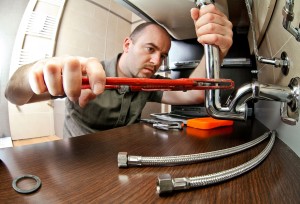We hate leaky faucets. In fact, we hate them so much that we'd rather do almost anything but fix them.

Our hopes of them just going away on their own are often dashed by the drip, drip, drip get bigger, louder, and more pronounced.
Leaky faucets account for 10% of your water bill each month. The average faucet can spill up to 10,000 gallons of water per year.
That is a considerable amount of wasted water per household.
Knowing what is going on inside your plumbing can help your understand why leaks happen and how the plumbing pros at TV Plumbing & Sewer can help you tackle them before they worsen and become more costly.
Common Causes & Easy Fixes to Faucet Problems
- Loose O Ring - The handle is held down by a stem screw. An O ring is attached to the screw. If the O ring becomes loose or is worn out, then leakage can occur. The O ring simply needs to be replaced and attached to the handle.
- Valve Seat Corrosion - a valve seat functions as a bridge between the faucet and the faucet spout in the compression area. When water sediment build up it can slowly eat away at the valve, weakening it and allowing water to seep through. With simple routine cleaning, the valve will last a long time.
- Worn Washer - The is a common cause of dripping in any faucet system. the washer experiences ongoing movement when the faucet handle is engaged. The movement creates friction which ultimately wears the washer out. Simply replacing the washer can fix the problem.
- Washer Installation - Like other parts of your faucet, if the washer is improperly installed or replaced then water will easily trickle out. An experienced professional plumber should know how to replace and properly install the washer in any faucet system. Once the washer is implemented correctly, the dripping will instantly stop.
- Loose Components - Every time you turn the handles on or adjust the positioning of your faucet you move several parts. Over time any of these components can become loose and simply need tightening or replacement in order to keep water from leaking.
- Old Seals - Seals can succumb to the same type of corrosion that affects valve seats. When water sediment eats away at an inlet or outlet seal, then eventually water will leak out. They cannot repair, but need to be replaced instead. A professional plumbing technician can clean the seals and the inlets/outlet area of your faucet in order to keep your seals clean. Only a professional can perform this job without risk of damage to your faucet.
- Damaged Pipes - Pipes are made of stainless steel or even iron. Although damage is unlikely, it does occur from time to time. Damage generally happens near the areas of connection and usually due to unnecessary movement. Cracks and holes in the plumbing need to be repaired or sealed. If you have considerable damage, then your pipes need to be replaced.
 TOP RATED PLUMBER
TOP RATED PLUMBER